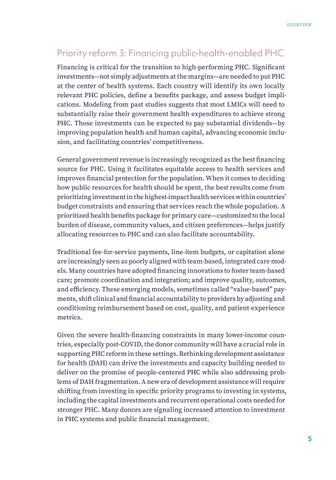OVERVIEW
Priority reform 3: Financing public-health-enabled PHC Financing is critical for the transition to high-performing PHC. Significant investments—not simply adjustments at the margins—are needed to put PHC at the center of health systems. Each country will identify its own locally relevant PHC policies, define a benefits package, and assess budget implications. Modeling from past studies suggests that most LMICs will need to substantially raise their government health expenditures to achieve strong PHC. Those investments can be expected to pay substantial dividends—by improving population health and human capital, advancing economic inclusion, and facilitating countries’ competitiveness. General government revenue is increasingly recognized as the best financing source for PHC. Using it facilitates equitable access to health services and improves financial protection for the population. When it comes to deciding how public resources for health should be spent, the best results come from prioritizing investment in the highest-impact health services within countries’ budget constraints and ensuring that services reach the whole population. A prioritized health benefits package for primary care—customized to the local burden of disease, community values, and citizen preferences—helps justify allocating resources to PHC and can also facilitate accountability. Traditional fee-for-service payments, line-item budgets, or capitation alone are increasingly seen as poorly aligned with team-based, integrated care models. Many countries have adopted financing innovations to foster team-based care; promote coordination and integration; and improve quality, outcomes, and efficiency. These emerging models, sometimes called “value-based” payments, shift clinical and financial accountability to providers by adjusting and conditioning reimbursement based on cost, quality, and patient-experience metrics. Given the severe health-financing constraints in many lower-income countries, especially post-COVID, the donor community will have a crucial role in supporting PHC reform in these settings. Rethinking development assistance for health (DAH) can drive the investments and capacity building needed to deliver on the promise of people-centered PHC while also addressing problems of DAH fragmentation. A new era of development assistance will require shifting from investing in specific priority programs to investing in systems, including the capital investments and recurrent operational costs needed for stronger PHC. Many donors are signaling increased attention to investment in PHC systems and public financial management. 5


